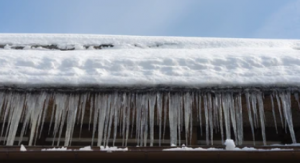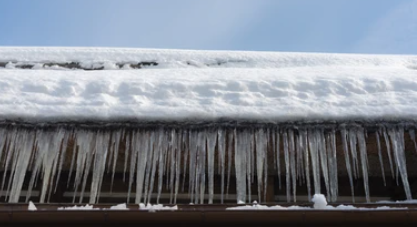The winter season brings snow, ice, and cold temperatures that can cause problems for your home. One of the biggest sources of property damage caused by winter conditions is ice dams. Ice dams can cause structural damage by putting stress on your roof and gutters and cause serious water damage by trapping melted snow and ice on your roof. Homeowners should take steps to help prevent the formation of ice dams this winter and know what to do to get rid of ice dams if they form.
In this guide, we will discuss ice dams including how they form and the damage they cause as well as steps you can take to prevent and remove ice dams. Ice dams can be quite damaging to your home as they can result in serious water damage and structural damage. Our professionals at ServiceMaster NCR can help homes affected by water damage from ice dams with our water damage restoration services.
What are Ice Dams?
Ice dams are large ridges of ice that form at the edge of the roof. They develop when poor insulation causes the temperature of the roof to be uneven which melts ice and snow over warmer sections in the middle of the roof. As the ice and snowmelt runs towards the colder edge of the roof to drain, it will refreeze and form a ridge that blocks the gutters and prevents further drainage from melted snow and ice.
How Do Ice Dams Cause Damage?
The ice dams that form at the edge of the roof trap melted snow and ice, causing it to pool in areas in the middle of the roof. The ice and snowmelt that does make it to the edge of the roof will refreeze on the ice ridge, making the ice dams even bigger. The weight of the ice dam can cause structural damage to the roof as well as damage to the gutters.
Ice dams can damage your home in the following ways:
- Water damage: Poor attic insulation causes the roof to heat up in areas which melts ice and snow. As the ice dams form, the melted snow and ice pools on the roof and seeps under the shingles which can cause leaks inside the home. The surrounding building materials both inside and outside, including walls and ceilings in the home, will absorb the water which can lead to structural damage. Water damage may also occur when melted snow and ice runs down the side of the home instead of draining properly through the gutters. This can result in water damage to the siding as well as the foundation.
- Structural damage: Ice dams can result in structural damage from the weight of the ice which puts a strain on the gutters and roof including the eaves, soffit, and facia. The bigger the ice dams, the more structural damage they can cause under their weight. The water damage that results from the melting ice and snow can also cause structural damage to the affected materials.
- Mold growth: Where there is water damage, there is also a high risk for mold. Water damaged wood, drywall, insulation, and other materials are highly vulnerable to mold growth which can cause additional structural damage and threaten your health.

Ice Dam Prevention
The best way to protect your home from ice dams is to take steps to prevent them from forming. You can prevent the formation of ice dams with the following tips:
- Clear the roof: Clearing snow from your roof after a snowfall can reduce the risk of ice dams as there will be less snow to melt and refreeze. Make sure you use a roof rake so you can remove the snow safely while standing on the ground. Removing heavy snow from the roof can also help prevent structural damage.
- Seal and insulate your attic: The biggest cause of ice dams is heat escaping through the attic and melting the ice and snow on the roof. Heat may escape from your attic due to poor insulation or air leaks from gaps in wood, drywall, chimneys, and light fixtures. Make sure you find and patch all cracks and gaps in your attic that may allow heat to escape. You also need to make sure your attic is properly insulated to hold in the heat. There should be 12-14 inches of fiberglass or cellulose insulation in your attic.
- Install roof and soffit vents: Roof and soffit vents can help keep your attic cool by pushing out warm air and taking in cold air from outside. This will help prevent your attic from warming up enough to melt snow and ice on the roof. It is best to have a professional install these vents.
- Install IC rated light fixtures: Insulation contact (IC) light fixtures are installed in insulated ceilings, and they help prevent heat from getting into your attic. These light fixtures can also lower the risk of fires.
Ice Dam Removal
Ice dams may still form on your roof despite your best efforts to avoid them. If you notice ice dams, do not try to remove them by breaking up the ice with a hammer, pick, or shovel. Attempting to remove ice dams in this way will likely result in further damage to your roof. You should also avoid using chemicals and salt as these materials can damage your roof as well.
The following are tips to help you safely and effectively remove ice dams from your roof:
- Cool your attic: You can help prevent the ice dams from getting bigger by cooling down your attic to stop the ice and snow from melting and getting the water to refreeze. You can do this by aiming a fan at the areas of the roof where the ice and snow have melted.
- Use hot water: You can melt the ice over the gutters by running hot water over it from a garden hose. This will clear a path for the melted snow and ice to drain from the roof. Make sure you use a gentle stream to melt the ice and take every precaution necessary when using a ladder in the snowy, icy conditions.
- Install heat cables: Heat cables can help melt snow and ice on your roof before ice dams form, but they must be installed before the winter. You should call a professional to have these installed properly.
- Remove snow: If ice dams have already formed on your roof and there is warmer weather coming, use a roof rake to remove as much snow as possible. Removing the snow before warmer temperatures start melting the ice will reduce the amount of water and help prevent water damage to your home.
- Call a professional: There are professionals out there who can remove ice dams safely and effectively without causing additional damage to your home. If the removal methods mentioned above do not fully remove the ice dams, contact a professional.
Water Damage Restoration from ServiceMaster NCR
Ice dams are dangerous because they can result in serious structural damage, water damage, and even mold growth. Taking the preventative actions discussed above will reduce the risk of ice dams forming and help prevent water damage or structural damage. If an ice dam has caused this type of damage to your home, our professionals at ServiceMaster NCR can help.
At ServiceMaster NCR, we provide water damage restoration services to restore damage caused by melting ice and snow. Our professionals can remove the water and moisture using advanced extraction and drying equipment and we can repair structural damage caused by water to walls and ceilings. We can also provide mold removal if mold has formed as a result of the water damage, and we use the innovative InstaScope pre- and post-testing method to ensure that all mold is discovered and removed.
ServiceMaster NCR is available 24 hours a day at (202) 318-6899 for emergency disaster restoration in the Alexandria, VA and Washington, DC areas.













